Topics 2019
December
Ambassador of Belgium visits the Port of Nagoya
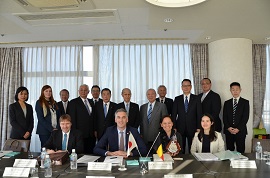
On December 10th, Belgian Ambassador Ms. Roxane de Bilderling visited the Port of Nagoya with a party from Flanders Investment & Trade. It was Ambassador Ms. Roxane de Bilderling’s first time since she took up the post of Belgian ambassador to Japan last summer. Companies at the Port of Nagoya that are expanding their business in Belgium and Nagoya Port Authority representatives were present and exchanged information, including an introduction to the Port of Nagoya and the present status of logistics.
First call of Hua Hang Han Ya 1 at the Port of Nagoya
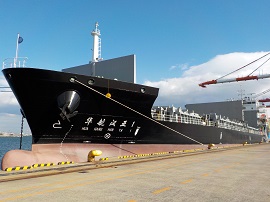
On December 4th, the Port of Nagoya welcomed the Hua Hang Han Ya 1 with an onboard welcome ceremony. Wuhan New Port Datong International Shipping Co., Ltd. has opened a direct container route between Japan and Wuhan, located on the middle stretch of the Chang Jiang River. The company also constructed two new 560 TEU container vessels that can navigate both the Chang Jiang River and the open sea. This route eliminates the need for transshipment at the Port of Shanghai and greatly reduces the number of days for transportation.
November
LNG tug boat Ishin makes first call at the Port of Nagoya and conducts bunkering experiment
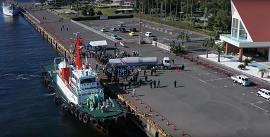
On November 7th, the Port of Nagoya welcomed the Ishin. The next day, Mitsui O.S.K. Lines, Ltd. and Toho Gas Co., Ltd. successfully performed the first bunkering experiment on an LNG-fueled tug boat at the Port of Nagoya. In this experiment, LNG was transported via truck from the Toho Gas Chita-Midorihama LNG Terminal and supplied via a truck-to-ship system to the Ishin, berthed at the Garden Pier.
October
Visit of Green Award Foundation
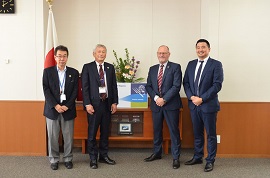
On October 28th, a nonprofit corporation, the Green Award Foundation (head office: Rotterdam, Netherlands) visited the Port of Nagoya for an exchange of opinions. This foundation was established with the aims of conserving the marine environment and promoting safe vessel operation. The Nagoya Port Authority joined the “Green Award Program,” which this foundation has conducted worldwide since November 2016. This objective of this program is to promote conservation of the marine environment and safe vessel operation with the cooperation of participants, including certified vessel owners, port management bodies, port related business providers and financial institutions.
September
First call of training ship M/V KAPITAN GREGORIO OCA at the Port of Nagoya
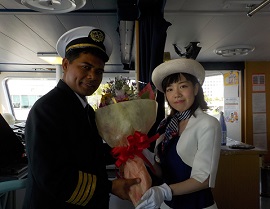
On September 9th, the training ship M/V Kapitan Gregorio OCA made its first call at the Port of Nagoya. This ship, a training ship of the Maritime Academy of Asia and the Pacific (MAAP), came to No. 3 berth at Garden Pier at the Port of Nagoya from the Philippines via the Port of Hiroshima. On the next day, a welcome ceremony was conducted on the ship.
MAAP is a merchant marine school managed by AMOSUP, and its biggest crew partner. In addition, this ship is used to train Filipino crews, who must ensure the safety of navigation as members of the Japanese merchant fleet.
• Basic information
Gross tonnage: 2098t
Nationality of ship: Philippine
June
Visit of China Ports and Harbours Association delegation
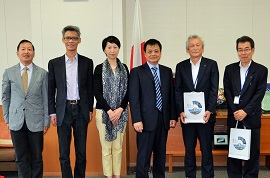
A delegation from the China Ports and Harbours Association came to the Port of Nagoya for training over 5 days from June 10th to 14th. During that time, they toured port facilities and related companies at the Port of Nagoya and received lectures on port management in Japan. The Port of Nagoya has accepted trainees from ports and related organizations in China every year since 1985 to deepen friendship and promote trade between Japan and China.
May
First call of new ship Izumimaru at the Port of Nagoya
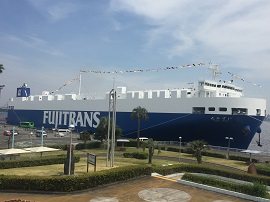
On May 27th, a Ro-Ro ship for domestic destinations, the Izumimaru, made its first call at the Port of Nagoya. A welcome ceremony was conducted onboard. The number of completed automobiles exported from the Port of Nagoya is not only the largest in Japan, but the outgoing shipments of completed automobiles to other domestic ports also accounts for about 70% of outgoing items. Completed automobiles are the most important items at the Port of Nagoya. The Izumimaru can carry about 1500 cars and was launched on May 24th. Centered in Nagoya, it will deliver completed automobiles to all parts of Japan, stopping in the Kanto, Chugoku, Shikoku and Kyushu regions.
• Basic information
Gross tonnage: 13,038 t
Total length: 165.0 m
Carrying capacity: 52-chassis and 1,447-car
Shoyo Maru First calls at the Port of Nagoya
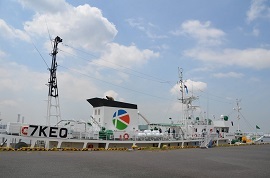
The Port of Nagoya welcomed the Shoyo Maru, a ship for fisheries high school students managed and used by both Oita prefecture and Kagawa prefecture, at the Garden Pier No. 2 Berth.
The Shoyo Maru is a newly built ship characterized by its white paint with blue lines, colorful funnel mark and low ship hull. In addition, it is equipped with a system that monitors the crew going out and in at night and a sensor to prevent from crew from sleeping in the steering house.
• Basic information
Total length: 64.37 m
Gross tonnage: 673 t
Maximum number of passengers: 82
Spring flood drill conducted
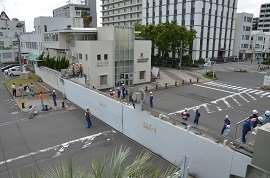
A spring tide gates closure drill was conducted at Garden Pier on May 20.
The purpose of the drill was for NPA staff to reconfirm the operational procedure and raise awareness of disaster prevention through actual closing of the gates.
The closing and opening of the gates during the drill were carried out manually and automatically while pedestrians and cars were guided safely.
• Tide gate
Tide protection walls with a total length of 26.4 km (16.4 miles) are located throughout the Port of Nagoya near the shoreline. The walls are made of concrete, with heights varying from 6.0 m to 6.8 m above sea level. They were built to protect the lives and properties of local residents from high tides and tsunamis, based on lessons learnt from the storm surge damages suffered in the Ise Bay Typhoon of 1959.
The walls have passageways for pedestrians and cars to go through. When high tides or tsunamis are predicted, these passageways will be closed with metal gates.
These gates are called “tide gates.”
April
Port of Nagoya Promotional Video "The Mission" is Released
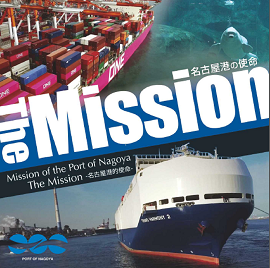
A new Port of Nagoya promotional video has been made to introduce to the port to visiters and related parties.This video is divided into 5 chapters that introduces the roles of the Port of Nagoya.
Composition
- 1st Mission Advantages of the Chubu Region
- 2nd Mission Support for Manufacturing
- 3rd Mission Support Comfortable Living in the Chubu Region
- 4th Mission Create a Safe and Secure Port
- 5th Mission Create a Lively Port
